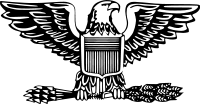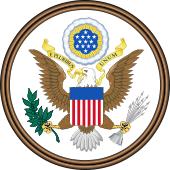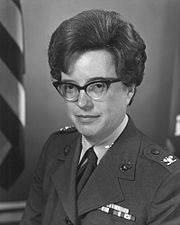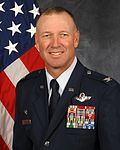- Colonel (United States)
-
Main article: Colonel
In the United States Army, Air Force, and Marine Corps, colonel is a senior field grade military officer rank just above the rank of lieutenant colonel and just below the rank of brigadier general. It is equivalent to the naval rank of captain in the other uniformed services.
The pay grade for the rank of colonel is O-6.
Contents
Insignia
 William Few in the uniform of a Continental Army colonel
William Few in the uniform of a Continental Army colonel
The insignia for a colonel is a silver eagle which is a stylized representation of the eagle dominating the Great Seal of the United States (which is the coat of arms of the United States). As on the Great Seal, the eagle has a U.S. shield superimposed on its chest and is holding an olive branch and bundle of arrows in its talons. However, in simplification of the Great Seal image, the insignia lacks the scroll in the eagle's mouth and the starry rosette above its head. On the Great Seal, the olive branch is always clutched in the eagle's right-side talons, while the bundle of arrows is always clutched in the left-side talons. The head of the eagle faces towards the olive branch, rather than the arrows, advocating peace rather than war. As a result, the head of the eagle always faces towards the viewer's left.
Among all branches of the uniformed services, the rank insignia of the silver eagle is ordinarily worn in matching mirrored pairs, such as on the left and right collar or left and right shoulder of various military uniforms. Army, Navy, Air Force, and Marine Corps regulations specify that when worn in such fashion, the head of the eagle will always face towards the front. Hence, on the left collar or left shoulder, the eagle appears to be looking to its right and the olive branch is clutched in the right-hand talon. On the right collar or right shoulder, the eagle appears to be looking to its left and the olive branch is clutched in the left-hand talon.
However, when worn as a single insignia with no matching pair, such as on the patrol cap, garrison cap, or the front of the ACU uniform, there is a split between the services on which mirror image of the eagle should be worn. In the United States Army and Air Force, the eagle is always worn with "the head of the eagle to the wearer's right," with the olive branch clutched in the eagle's right hand talons (see Army Regulation 670-1, paragraph 28-6 (a)(1)). In the United States Navy and Marine Corps, the eagle is worn with "the head facing forward" on the garrison cap (see Marine Corps Order P1020.34G, Uniform Regulation, paragraph 4005d(1)). Since the insignia is worn on the right hand side of the Navy and Marine garrison cap, the eagle is facing to the eagle's left with the olive branch clutched in the eagle's left hand talons, which is a mirror opposite to the wear of the single eagle for Army and Air Force officers.
Origins
The United States rank of colonel is a direct successor to the same rank in the British Army. The first colonels in America were appointed from Colonial militias maintained as reserves to the British Army in the American colonies. Upon the outbreak of the American Revolutionary War, colonial legislatures would grant commissions to men to raise a regiment and serve as its colonels. Thus, the first American colonels were usually respected men with ties in local communities and active in politics. Such was the origin of the term "soldier and statesman."
The first insignia for the rank of colonel consisted of gold epaulettes worn on the blue uniform of the Continental Army. The first recorded use of the eagle insignia was in 1805 as this insignia was made official in uniform regulations by 1810.
19th century
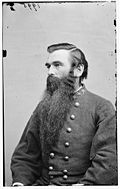 A colonel of the Confederate Army wearing the three-star insignia
A colonel of the Confederate Army wearing the three-star insignia
The rank of colonel was relatively rare in the early 19th century, partly because the Army was very small, and the rank was usually obtained only after long years of service. During the War of 1812 many temporary colonels were appointed, but these commissions were either considered brevet ranks or the commissions were canceled at the war’s conclusion.
The American Civil War saw a large influx of colonels as the rank was commonly held in both the Confederate Army and Union Army by those who commanded a regiment. Since most regiments were state formations and were quickly raised, the colonels in command were known by the title "Colonel of Volunteers," in contrast to Regular Army colonels who held ranks from the "old school" of the professional army before the Civil War.
During the Civil War, the Confederate Army maintained a unique insignia for colonel, three stars worn on the collar of a uniform. Robert E. Lee wore this insignia due to his former rank in the United States Army and refused to wear the insignia of a Confederate general, stating that he would only accept permanent promotion when the South had achieved independence.
After the Civil War, the rank of colonel again became rare as the forces of the United States Army became extremely small. However, many brevet colonels were appointed again during the Spanish American War, prominent among them Theodore Roosevelt and David Grant Colson.
20th century
World War I and World War II saw the largest numbers of colonels ever appointed in the United States armed forces. This was mostly due to the temporary ranks of the National Army and the Army of the United States, where those who would normally hold the rank of Captain in the peacetime Regular Army were thrust into the rank of colonel during these two wars.
It was also during World War I that a tradition developed in that colonels would wear the eagle insignia with the head pointing outwards from the neck as if to “face the enemy”. This was in contrast to the Army uniform regulations of the time, which stated that the eagle would be worn on the left collar, with the beak of the eagle facing inwards towards the wearer’s neck. Photographic evidence and service records from the Military Personnel Records Center indicate that this tradition lasted into World War II, after which time more strict uniform regulations prevented colonels from reversing the insignia in this fashion. The United States Navy also picked up this tradition, and Midshipmen today are taught that during times of war Navy Captains will reverse their collar insignia (which is the same eagle insignia as that of colonel) in order to have the eagle facing the enemies of the United States.
By the end of the Korean War appointments to the rank of colonel were standardized to be granted after roughly 16–18 years of service in the military; however temporary colonel appointments continued well into the Vietnam War. The last temporary appointments to the rank of colonel were in the late 1970s; since then all colonels have received permanent appointments upon promotion. Currently an officer reaches the rank of colonel after around 20–22 years of military service.
Modern rank
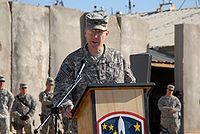 A modern Army colonel wearing the ACU
A modern Army colonel wearing the ACU
Modern American colonels usually command infantry brigades, USAF groups or wings, and USMC regiments. An Army colonel typically commands brigade-sized units (4,000 to 6,000 Soldiers), with a Command Sergeant Major as a senior non-commissioned officer advisor. An Air Force colonel typically commands a wing consisting of 1,000 to 3,000 airmen with a Command Chief Master Sergeant as principal NCO adviser. Some colonels are commanders of groups, which are the major components of wings. Colonels are also found as the chief of staff at divisional level-(Army) or Numbered Air Force-level staff agencies.
In the modern armed forces, the colonel's eagle is worn facing inwards with head and beak pointing towards the wearer's neck. Of all U.S. military commissioned officer rank, only the colonel's eagle has a distinct right and left insignia. All other commissioned officer rank insignia can be worn on either the right or left side.
Colonels are sometimes referred to (but not addressed) as full-bird colonels or "O-6," which is their pay grade, in order to differentiate between colonels and lieutenant colonels, since lieutenant colonels are also referred to and addressed as simply "colonel." In the Army, a colonel who has been selected for promotion to brigadier general is authorized to use Colonel (P) (as in Promotable) when signing official documents. In all other branches the officer still uses colonel until the date of his actual promotion.
An old Army saying, contrasting the leaf insignia of majors and lieutenant colonels with those of a general goes, "Once the leaves fall there's nothing between an eagle and the stars."
Most Army colonels are trained at the Army War College in Carlisle, Pennsylvania.[1] The 2009 graduating class was 336 including 198 army officers and the rest divided among other military branches as well as foreign military leaders.[2] In most state police/highway patrol agencies, the chief of police holds the title of colonel.
Honorary colonels
Main article: Colonel (title)Some people known as "colonels" are actually recipients of honorary colonel ranks from a state governor and are not officers of the U.S. armed forces. In the 19th century the honorary colonels were military appointments and they still are nominally appointed to governor's staff, but without military rights or duties. Famous honorary colonels include Colonel Harland Sanders of KFC fame, a Kentucky colonel; Colonel Tom Parker, Elvis Presley's manager, who received the honor from a Louisiana governor; and Edward M. House, known as Colonel House, a Texas honorary colonel and adviser to President Woodrow Wilson.
Famous American colonels
- Alexander Butterfield—U.S. Air Force colonel who became an aide to President Nixon and was later appointed administrator of the Federal Aviation Administration. Cooperated with prosecutors during the Watergate scandal.
- Ambrosio José Gonzales—Cuban revolutionary who fought for the US annexation of Cuba before serving as a colonel in the CSA.
- Edwin Eugene "Buzz" Aldrin—Second person to step on the moon.
- Charlie Beckwith—Founder of 1st Special Forces Operational Detachment-Delta, the Army's elite top-secret special forces detachment.
- David Hackworth—Served in Korea and Vietnam, an author and military media consultant. Formerly the highest decorated living soldier.
- Ed McMahon—United States Marine Corps aviator and television personality.
- Federico Fernández Cavada- Union Army colonel who fought in the Battle of Gettysburg and later became the Commander-in-Chief of Cuban forces during the Ten Years' War.
- Henry Knox—As colonel of the Continental Regiment of Artillery in 1776, he brought guns from Ft. Ticonderoga to Dorchester Heights, forcing the British out of Boston the next morning. Later, President Washington made him Secretary of War as part of the first Presidential Cabinet in America. He also served in Washington's crossing of the Delaware River for the Battle of Trenton.
- Henry Rutgers—Revolutionary War colonel - philanthropist and namesake of Rutgers University.
- Jack H. Jacobs—Served in Vietnam, recipient of the Medal of Honor.
- Jeff Cooper—WWII and Korean War veteran and "The Father of Modern Shooting."
- John Boyd —Air Force fighter pilot and military strategist. Responsible for developing EM theory (Energy-Maneuverability theory), a method of determining the performance capabilities of a prospective fighter [plane] before production.
- John Glenn—Marine Corps aviator, astronaut, and U.S. Senator.
- John Jackson Dickison- led the Confederate forces which captured the USS Columbine, in the only known incident in US history where a cavalry unit sank an enemy gunboat.
- Joshua Lawrence Chamberlain—Commander of the 20th Maine Volunteer Infantry Regiment at Gettysburg.
- Martha McSally—United States Air Force first American woman to fly in combat.
- Robert E Lee—Led the raid against John Brown at Harpers Ferry, Commanding general of the Confederate Army.
- Robert Gould Shaw—Commander of the African American Army Regiment, the 54th Massachusetts.
- Theodore Roosevelt—1st United States Volunteer Cavalry Regiment recipient of the Medal of Honor.
- Virgil R. Miller- Regimental commander of the 442d Regimental Combat Team (RCT), a unit which was composed of "Nisei" (second generation Americans of Japanese descent), during World War II. He led the 442nd in its rescue of the Lost Texas Battalion of the 36th Infantry Division, in the forests of the Vosges Mountains in northeastern France.
- Wesley L. Fox—United States Marine Corps recipient of the Medal of Honor.
- William Moultrie—Defended Ft. Sullivan (later to be named Ft. Moultrie in honor of the colonel) against British attack in 1776; his regiment was later absorbed by the Continental Army, and he was promoted to brigadier general.
- Anthony G. Brown—Lieutenant Governor of Maryland (2007-present) and Commander of the 153rd Legal Support Organization in Pennsylvania; Highest-ranking elected official in the nation to have served a tour of duty in Iraq[3]; Co-Chair of the Obama/Biden Presidential Transition Agency Review Team for the Department of Veterans Affairs
See also
References
United States commissioned officer and officer candidate ranks Pay Grade / Branch of Service Officer
CandidateO-1 O-2 O-3 O-4 O-5 O-6 O-7 O-8 O-9 O-10 Special Special Approximate insignia (no universal insignia) 










 or
or 
Air Force CDT / OT 2d Lt 1st Lt Capt Maj Lt Col Col Brig Gen Maj Gen Lt Gen Gen GAF[1] [3] Army CDT / OC 2LT 1LT CPT MAJ LTC COL BG MG LTG GEN GA[1] General of the Armies[1] Marine Corps Midn / Cand 2ndLt 1stLt Capt Maj LtCol Col BGen MajGen LtGen Gen [3] [3] Navy MIDN / OC ENS LTJG LT LCDR CDR CAPT RDML RADM VADM ADM FADM[1] Admiral of the Navy[1] Coast Guard CDT / OC ENS LTJG LT LCDR CDR CAPT RDML RADM VADM ADM [1] [1] Public Health Service [3] ENS LTJG LT LCDR CDR CAPT RADM RADM VADM ADM [3] [3] National Oceanic and
Atmospheric Administration[3] ENS LTJG LT LCDR CDR CAPT RDML RADM VADM[1] [2] [3] [3] Grade inactive; requires Congressional approval for re-activation [1]
Grade is authorized for use by U.S. Code but has not been created [2]
Grade never created or authorized [3]United States warrant officer ranks W-1 W-2 W-3 W-4 W-5 Air Force WO1[1] CWO2[1] CWO3[1] CWO4[1] CWO5[1] Army WO1 CW2 CW3 CW4 CW5 Marine Corps WO1 CWO2 CWO3 CWO4 CWO5 Navy WO1[1] CWO2 CWO3 CWO4 CWO5 Coast Guard WO1[1] CWO2 CWO3 CWO4 [2] Public Health Service [2] [2] [2] [2] [3] National Oceanic and
Atmospheric Administration[3] [3] [3] [3] [3] Grade inactive [1]
Grade is authorized for use by U.S. Code but has not been created [2]
Grade never created or authorized [3]Categories:- Colonels (military rank)
- Military ranks of the United States Army
- Officer ranks of the United States Air Force
- United States Marine Corps ranks
Wikimedia Foundation. 2010.

